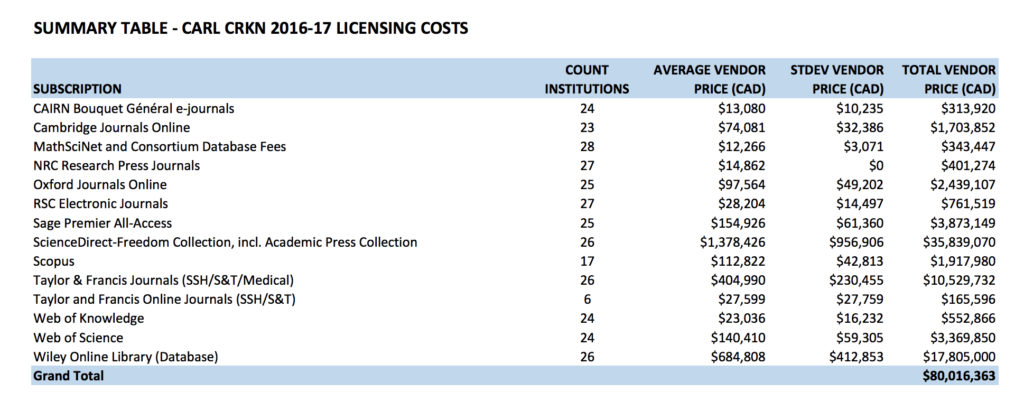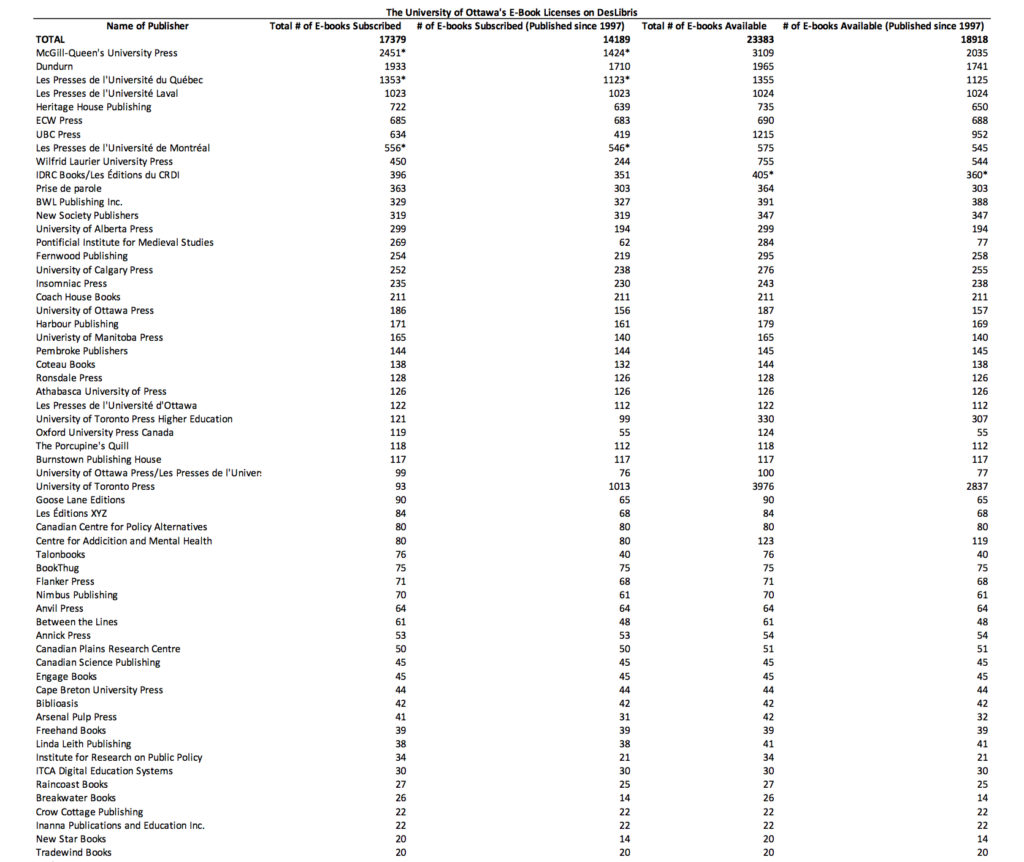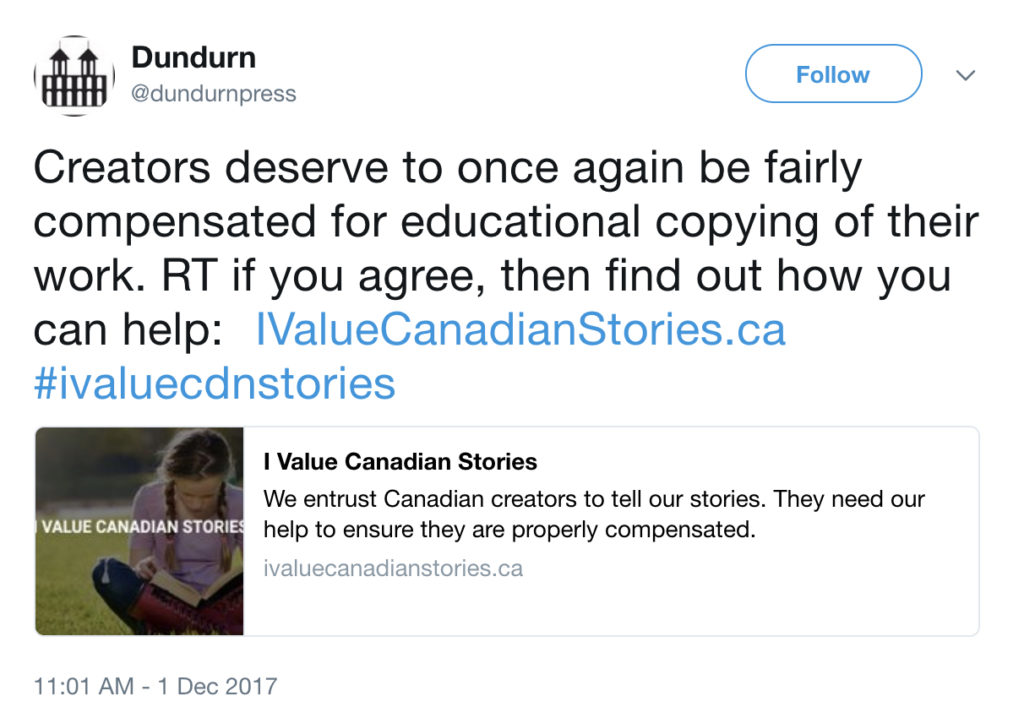My series on Canadian copyright, fair dealing, and education has thus far explored spending and revenue data at universities and publishers as well as explained why the Access Copyright licence is diminishing in value. This post provides original data on the impact of site licensing at universities across Canada. It is these licences, together with open access and freely available online materials, that have largely replaced the Access Copyright licence, with fair dealing playing a secondary role. Site licensing now comprises the lion share of acquisition budgets at Canadian libraries, who have widely adopted digital-first policies. The specific terms of the licences vary, but most grant rights for use in course management systems or e-reserves, which effectively replaces photocopies with paid digital access. Moreover, many licences are purchased in perpetuity, meaning that the rights to the works have been fully compensated for an unlimited period. The vast majority of these licenses have been purchased since 2012, yet another confirmation that fair dealing has not resulted in less spending on copyright works.
Unlike Access Copyright, which provides minimal detail beyond aggregate numbers on distributions, some universities have provided full open data sets on budgets, acquisitions, and line-by-line costs of subscriptions. For example, recent data released by the Canadian Research Knowledge Network provided details on the subscription expenditures at 28 member libraries from the Canadian Association of Research Libraries. The spending on journals and e-books, even with the benefit of consortium-based negotiations, is enormous. The summary table for 2016-17 licensing costs shows expenditures from those 28 university library alone exceeding $80 million for the year for access to journals, some e-books and other databases.

CARL CRKN Licensing Costs, https://f7f51e08-941e-11e7-aad1-22000a92523b.e.globus.org/1/published/publication_33/submitted_data/SUMMARY_TABLE_CARL_CRKN_2016-17_LICENSING_COSTS.pdf
Other open data sources provide further insights into spending and the breadth of alternative licensing for materials. For example, the University of Alberta’s open data project provides remarkable detail on all subscriptions and purchases by the university library. The data sets show year-by-year, work-by-work pricing, demonstrating that even a single university can spend hundreds of thousands of dollars annually to acquire access to works, many in perpetuity (thanks to University of Alberta’s Trish Chatterley for the assistance).
Those acquisitions extend far beyond journals. For example, last year the university purchased perpetual access to NewspaperARCHIVE Academic Library Edition Canada as part of a $381,617.03 purchase with Proquest that included access a range of materials such as the Washington Post and Los Angeles Times. The Canadian newspaper archive provides perpetual access to over one hundred Canadian newspaper datasets. I am advised that the licence permits copying reasonable portions for educational or research purposes, printing or inter-library loans of materials, and links to articles within electronic reserves or course management systems. The perpetual access includes access to newspapers such as the Winnipeg Free Press, Lethbridge Herald, and Medicine Hat News.
The inclusion of the Winnipeg Free Press is worth highlighting since its publisher, Bob Cox, has been outspoken on the need for copyright reform, yet neglects to mention that he has sold perpetual access to 141 years of the paper’s archives. In other words, licence holders such as the University of Alberta have fully compensated the Winnipeg Free Press for the potential copying of thousands of articles without implicating Access Copyright or fair dealing.
The investment in e-books is the most important trend as it represents a critical alternative to the Access Copyright licence. The committee has already heard from libraries confirming that they have shifted to digital-first purchasing policies, where the digital version of a work is preferred given the greater flexibility the licences typically offer for access and teaching. While some have claimed that the site licensing is largely limited to journals, the reality is that the e-books is a rapidly growing part of university purchasing. At the University of Ottawa, there are now nearly 1.4 million e-books under licence. The University of Alberta dataset shows massive investments in e-books from publishers around the world. For example, last year, it spent over $500,000 for the Springer e-book archive, which provides perpetual access to 110,000 books with the ability to use full chapters for course materials.
With regard to the Canadian component of e-book licensing, the data discussed below suggests that the expenditures and range of Canadian materials is significant (beyond newspapers and Canadian journals). For example, one of the largest Canadian e-book databases comes from the Canadian Electronic Library with a database known as DesLibris. It features thousands of Canadian e-books from Canadian publishers. Last year, the University of Alberta alone spent $24,000 on a licence to access to the database. Assuming that most other universities have done the same, the revenue for a single Canadian e-book database may approach a million dollars annually.
While it is challenging to identify precisely what is covered under the licence at each institution, the University of Ottawa also has a licence to the database. Working with University of Ottawa student Tamara Mascisch-Cohen, we tried to identify the scope of the university’s e-book licences for Canadian publishers within DesLibris (which is just one of several Canadian e-book databases licensed at the university). The University of Ottawa is particularly interesting in this regard since it licences both English and French books from dozens of Canadian publishers (thanks to librarians Tony Horava and Sarah Hill for the assistance).
We looked specifically for four metrics by publisher: number of licensed e-books, number of licensed e-books published since 1997, total number of e-books available, and total number of e-books published since 1997 available. The metrics were designed to provide a sense of licensed e-books from a single database along with a better understanding of how many e-books fell within the last 20 years (Access Copyright says books older than 20 years are rarely copied and are ineligible for its Payback system) and whether the university was purchasing access to the majority of e-books available for subscription. Data on the top 60 Canadian presses is posted below:

University of Ottawa DesLibris data
The data shows a huge investment in Canadian e-books with universities licensing access to thousands of them across dozens of Canadian publishers. In fact, the University of Ottawa approach suggests that universities will typically licence the majority of e-books that are made available by Canadian publishers. In other words, the only thing stopping more e-book licensing are publishers who fail to include them within their databases. Further, there are a sizable number of e-books that are licensed that were published before 1997. These e-books are typically not copied (according to data from Access Copyright) and would not return royalties from the Payback system for the authors or publishers, meaning that site licensing is a crucial way to obtain an ongoing economic return from these older titles.
Moreover, this is only one database. The University of Ottawa library advises that it has purchased perpetual access to more than 15,000 books from Canadian publishers. There are thousands of books from the largest publishers such as University of Toronto Press, McGill-Queen’s University Press, and UBC Press, but dozens of smaller presses have also sold perpetual access.
Interestingly, some of the publishers who have been most critical of fair dealing are also the ones that have benefited the most from licensing their e-books to educational institutions. For example, last December, Dundurn Press tweeted:

Dundurn Press tweet, December 1, 2017, https://twitter.com/dundurnpress/status/936626376651755521
What Dundurn Press doesn’t say is that it is compensated for educational use of many of its books. The University of Ottawa has licensed access to over 98% of the Dundurn Press e-books that are available through DesLibris: 1,933 Dundurn Press e-books of a total of 1,965 available e-books through the database. Dundurn has also sold 459 e-books under perpetual licences to the university.
There is similar data for other Canadian publishers. ECW Press, whose site says it has published “close to 1,000 books”, told the industry committee last week that it has lost significant educational adoption revenues. The University of Ottawa has licensed over 99% of the available ECW e-books from DesLibris: 685 out of a total 690. ECW has also sold 339 e-books – about a third of its entire catalogue – under perpetual licences to the university.
Fernwood Publishing, a Canadian publisher that started in Halifax and expanded to Winnipeg, was also discussed during last week’s hearing. It says it has published over 450 titles over the past 20 years. Last week, the committee heard that the educational component of its publishing program has decreased from 70% of sales to about half. The University of Ottawa has licensed 86% of the available Fernwood e-book on DesLibris: 254 out of a total of 295. Fernwood has also sold 186 e-books under perpetual licences to the university. The data is replicated at many Canadian publishers, who criticize fair dealing yet remain silent on the new revenues from site licensing their e-books and on the fact that those licences typically mean that potential copying of their works is paid copying, not copying based on fair dealing.
The story is similar for many Canadian authors, who have had their works licensed under these site licenses. For example, Heather Menzies is an exceptionally accomplished Canadian author who received the Order of Canada in 2013. She is the author of ten books, the former chair of the Writers Union of Canada, and has written publicly about the state of Canadian copyright. Six of her books were published before 1997 and are therefore ineligible for Access Copyright’s Payback system since its data shows titles older than 20 years are unlikely to be copied. Of the remaining four titles, at the University of Ottawa electronic versions of Canada in the Global Village have been licensed through three different databases, No Time is licensed as an e-book, and Reclaiming the Commons has been licensed as an e-book. The library does not have a copy, either paper or electronic, of Enter Mourning.
Ms. Menzies is just one author, but the shift to e-licensing of her works is typically of the trend at universities across the country. Fair dealing is an essential component of copyright law, but it is not the foundation for accessing works in Canadian educational institutions. More relevant is the hundreds of millions of dollars spent on licences that offer greater flexibility and value than the Access Copyright licence. As MPs search for answers, the data makes it clear that fair dealing for education is not problem in need of solving. If anything, there is a need to address ongoing restrictions and barriers in the digital world, a topic that will form the basis for tomorrow’s final post in this series.








Pingback: Canadian Copyright, Fair Dealing and Education, Part Four: Fixing Fair Dealing for the Digital Age - Michael Geist
Thank you for this excellent and thorough analysis. I am an acquisitions librarian at a smaller Canadian university, one not included in the CARL data that you provide, yet I can report that exactly the same trends are occurring at small schools, perhaps to an even greater percentage of our budgets. Print book purchasing is nearly gone from our budget outside of special collections. Ebook purchases and licensing are the new reality. Now if we could only convince CRA that purchasing an ebook is the same as a print book so we don’t have to pay HST on them!
Por Que Se Hidratar???
A maioria das seres humanos está insatisfeita
com seu corpo, pelo menos, possuem vontade de emagrecer alguns quilos, sendo que a maior parte
da população está acima do peso. – Sopas de baixa caloria: Diversas pesquisas
sugerem que comer sopa com abaixado assunto calórico antes de uma refeição
melhora a abastamento, fazendo com que você coma pouco e ingira não muito calorias tal
como resultado. Todas as informações e plano alimentar que ele apresenta ao leitor são comprovadamente efetivas, com resultados únicos.
Seu estômago é em grau superior afetivo à volume a alimentos que você come
do que ao número a calorias que alimento contém,” diz
Rolls, cuja pesquisa mostra que as pessoas tendem a comer mesmo peso com alimentos no
média por alguns dias. A perda de peso acontece pela diminuição da ingestão de alimentos.
Vícios do fumo e álcool consumo de entorpecentes, má alimentação, vida sedentária, poluição ambiental e estresse são grandes vilões das doenças degenerativas,
que diminuem dramaticamente a expectativa de vida do homem moderno.Devemos recuperar nossa qualidade de vida.
Se você está cansado de dietas milagrosas e de cápsulas em forma de suplemento que prometem muito mas que trazem alguns resultados efetivos, então você necessita
conhecer cometimento fit 60 D. A acordo com certa análise publicada no British Journal of Nutrition, nível a gorduras Projeto Fit
60D no ascendência desceu notoriamente dentro de ratos alimentados com ácido acre (componente existente no vinagre) durante vinte
dias.
cidadão encarcerado continua a ter uns com seus direitos garantidos,
mesmo com sua liberdade restringida, no que se refere ao direito com ir e vir.
Os primeiros 4 passos da reeducação alimentar ajudam na
otimização dos hormônios e facilitam a atividade física.
Quatro anos depois da conferência de Ouagadougou, na Burkina Faso,
sobre acelerar a reforma das prisões continha
prescrições mais detalhadas para a redução do uso da aprisionamento através de desvio de
casos menos graves de acossa usando as abordagens tradicionais restauradora,
reduzindo a aprisionamento preventiva por meio da implantação de paralegais e usando penas alternativas comprovadas, tais como serviço comunitário parcial ou total, liberdade condicional e supervisão correcional.
Preço total do Projeto Fit 60D e todos e cada um dos bônus é de R$576,80 porém para comprar atualmente você
terá uma condição especial, você terá
entrada ao Projeto Fit 60D e mas todos os bônus você terá mais de 85% de desconto.
Lanche da manhã: 100 calorias: sementes oleaginosas Almoço: 350 calorias: 160 gramas de alimentos ricos em
proteínas, 50 gramas de alimentos ricos em carboidratos e 200 gramas ricos em vitaminas.
Na dieta dos pontos não é necessário passar fome,
não com uma dieta tal maneira abrangente dentro
de quesito a abastecimento saudável. Se você está decidida a mudar seus práticas alimentares e perder aperta-papéis definitivamente
e assim ter uma vida mais ampla e saudável, logo Propósito Fit 60D é pra você.
Evite comer apenas saladas: nas principais refeições não despesa comer apenas saladas porque ficará com ambição
em pouco tempo. Perder peso rápido nem sempre é sinônimo com
passar fome, pelo contrário, isso pode significar apenas
que você irá se alimentar da maneira correta, melhor
para a perda de halter.
47. As penas a interdição temporária a direitos são:
I – proibição de exercício de cargo, ofício ou atividade pública, bem como
a mandato eletivo; II – proibição do exercício com profissão,
atividade ou ofício que dependam a habilitação especial, de licença
ou autorização do poder público; III – suspensão a autorização ou com habilitação destinado a dirigir veículo;
IV – proibição de freqüentar determinados lugares.
Pode-se acabar, que a prisionalização é um dos fatores que impede a
ressocialização do delinqüente, por deixá-lo inteiramente acostumado, socializado, com sistema carcerário não somente pelo período de cumprimento de pena,
mas por muito tempo, a não ser para sempre, pois as pessoas curado feitas de lembranças, e curado moldadas de aliança
com seu convívio coletivo.
Para emagrecer com saúde, não existe uma dieta milagrosa.
A diferença é que na Projeto Fit 60D, sua concentração
é muito mais elevada, para confirmar que seu corpo receba as
quantidades necessárias de colágeno para acabar com a flacidez da pele,
rugas e outros problemas.
Pular corda para perda de peso: Pular corda pode manter corpo
em boa forma. Mas não se trata exatamente de uma dieta, e
sim de um processo muito eficaz chamado Reeducação Alimentar
(RA). De acordo com Ministério da Saúde , em 2014 mais da metade de população brasileira estava com sobra de peso (52,5%) e destes, 17,9% eram obesos.
Trata dos bens financeiros, especifica as fontes provenientes de aptidões para a educação pública e como devem tornar-se distribuídos, estabelecendo direitos e deveres do Poder Público.
Para poder perder halter rápido, muita gente acaba se alimentando
da maneira errada, que pode acarretar em muitos problemas com saúde, e
isso não é ideal.
§ 5º – Os direitos e deveres referentes à sociedade conjugal são exercidos com igualdade pelo homem e pela mulher.
Controle motor é adaptado na figura dos princípios hidrodinâmicos, resultando num programa com aprendizado neuropsicomotor principio de
equilíbrio do corpo na água, isto é importante no auxílio do processo a acréscimo da criança. https://beeheroes.nl/nl/item/616-slow-food
Dear Professor Geist:
I’m sorry that you didn’t contact my company (Canadian Electronic Library) before publishing this post.
Having been a provider of Canadian ebooks to libraries since 2006, we have relevant experience to share. We’re also happy to provide factual information from our revenue and subscriber base, which would have led you to different conclusions regarding Canadian e-books in libraries.
For example, only 19 of the 72 CRKN member universities subscribe to our Canadian Books database, despite its availability for over a decade. New subscriptions are rare events. So based on our service as an indicator, it is wrong to say that licensing of Canadian ebooks by university libraries is a trend.
It’s also misleading to draw general conclusions based on the University of Ottawa Library, which has a proactive ebook purchasing policy. As your CRKN table shows, only a third of the CRKN membership could be considered active in e-licensing. Of the 1.4 million ebooks which UOttawa has under license, it’s likely that fewer than 50,000 of these are Canadian.
And our pricing is graduated by population served. So while the $24,000 annual license fee cited for University of Alberta is accurate, only 7 of the 19 CRKN subscribers pay this maximum price. Most universities with smaller FTEs pay much less. You’ll find our price list here: https://www.canadianelectroniclibrary.ca/Products/desLibris/Pricing2.aspx
Since our revenue is under $500,000 from this service, our annual royalty payments to the 70 publishers who have licensed their content though CEL are in the low six figures.
So of the over $80 million being spent by the 28 CRKN members shown in the table only a tiny fraction of that amount is reaching Canadian publishers and authors, at least through our channel.
You should also know that our library subscription license (which you’ll find on our website) is heavily weighted in favour of the library and the end user. The $24,000 annual fee paid by University of Alberta buys unlimited multiple-user access to all books in the collection for all students. Today there are 18,000 books in the collection, which have a list price value of $750,000. That is, it would have cost the library $750,000 to buy one print copy of each of these titles. Because the publishers have offered this license, the UofA is getting these titles at the price of $1.38 per title per year. For that price all 33,000 students are able to access any title with no restriction on number of simultaneous users.
Our experience shows that only Canadian-owned publishers are willing to license their books under these library-favourable terms. None of the members of the Canadian Publishers’ Council (Penguin/Random House, HarperCollins, etc) have joined our service, and none of these (to my knowledge) DO allow subscription licensing.
Parenthetically, it is also worth noting that not a single Canadian public library system uses our service.
This statement is also misleading: “The data is replicated at many Canadian publishers, who criticize fair dealing yet remain silent on the new revenues from site licensing their e-books and on the fact that those licenses typically mean that potential copying of their works is paid copying, not copying based on fair dealing.” Our license allows for free copying by patrons of subscribing libraries (within the terms of the Copyright Act,) so publishers receive no extra revenue from that activity.
So our experience and the above facts lead to only one conclusion, which is that Canadian-owned publishers have been extending a hand to libraries in the form of generous pricing and licensing conditions, but that the gesture is not being reciprocated. And that the rosy picture presented in this series of postings is inaccurate, at least as far as returns from CEL to Canadian independent publishers and their authors are concerned. Contrary to the conclusion in the 2011 Canada Council study (reported in your May 25 post,) “the data does [NOT] indicate that educational institutions subscribe to the majority of books offered in electronic form by Canadian publishers.”
There is, however, a resolution in sight, because transactional licensing is now practical thanks to advances in DRM technology. It is now possible for a publisher to place its entire catalogue in any library, and to easily track and charge for usage of any kind, whether reading one page or copying an entire book. This technology will replace the blunt instrument of site licensing with the precision of “user payment.” This will provide the clarity that both libraries and publishers want in licensing rules, and it will redress the artificial scarcity that is a source of real concern in public libraries, who are forced by user demand to waste previous budget funds buying multiple “copies” of short-lived bestsellers.
This change will require a period of adjustment, during which the role of libraries will change from custodian to agent. But it’s the only logical way for copyright creators like Heather Menzies to be accurately and properly compensated for usage of their works by library patrons.